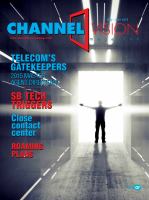

on individual agent endpoints, which can provide significant
management efficiencies.
Avaya, for instance, is collaborating with Google on a
cloud-based solution, dubbed the OnAvaya Powered by
Google Cloud Platform. It includes a subscription-based
license and the customer engagement OnAvaya software –
from there, users can provision a Chrome device and a head-
set. Customer service reps will be able to access the Cus-
tomer Engagement OnAvaya agent and supervisor desktops
with a Google Chrome device and communicate through a
WebRTC-enabled interface and headset.
In the U.S., certified Avaya and Google business partners
and Google for Work partners authorized by Avaya will be
able to sell the solution.
“Avaya is bringing its customer engagement technology
leadership to midmar-
ket companies with an
easy-to-use subscription
service,” said Joe Manu-
ele, senior vice president
and general manager
of global cloud services
at Avaya. “Through
the power of Google
Cloud Platform, Avaya
is providing a simple
and scalable foundation
that allows customers
and partners to deploy
contact centers faster,
and agents to work from
anywhere.”
“We continue to see
our customers transi-
tioning to cloud-based offerings to speed the implementa-
tion of business-critical customer engagement services,” said
Tony Bianco, president of the cloud computing division at
Onix, one of the first partners to pilot and offer the platform.
“This offer from Avaya, working with Google, eliminates
installation complexity and provides us with access to the
industry’s leading contact center software-as-a-cloud service.
We anticipate that customers in a variety of industries will be
very excited about this product offering.”
These traditional benefits are critical talking points in the
sales process. But there’s also a benefit (and additional value
for the channel partner) when it comes to providing differ-
entiating, omnichannel, personalized customer service.
It’s a Multichannel World
A January 2015 customer experience survey examined con-
sumer perceptions of service while making online or phone
purchases of more than $25 in the previous six months. The
study, conducted online by Harris Poll on behalf of inContact,
found that consumers expect a personalized, omnichannel
customer journey that includes agent service continuity and
choice of channels for follow-up communications.
In order of importance to consumers, preferred agent-sup-
ported channels include: email (93 percent); 1-800 to live reps
(81 percent); online chat (67 percent); apps for mobile devices
(50 percent); SMS/text message (46 percent); social network-
ing sites (39 percent); and online video chat (32 percent).
When feeling dissatisfied with an order, the majority (81
percent) of U.S. adults prefer assistance from a live repre-
sentative via phone or online chat rather than using email
or online self-service – but, they want these other channels
available too.
According to the findings, 43 percent of U.S. adults who
made at least one purchase online of more than $25 during the
last six months had interacted directly with a company rep-
resentative at least once, with an average of two interactions.
When purchasing via phone, 84 percent of buyers were in
touch with a company representative an average of five times.
“We set out to understand how shoppers interact with com-
panies when they are making purchases online or via phone,”
noted Paul Jarman, CEO of inContact. “Consumers still fre-
quently turn to agent-assisted channels in addition to using self-
service options during different stages of the purchase cycle,
which makes the contact center a vital link to the customer
experience when it matters most – when they are buying.”
A Focus on Personalization
Given this expectation for multichannel communication,
it’s perhaps unsurprising that personalization is a key to
loyalty and a good experience for consumers.
According to the InContact research, a full 65 percent
of U.S. adults expect customer service reps to know their
purchase history regardless of method of communication
(e.g., phone, chat, email). And, there’s a need for more focus
on transition times. About two-thirds (67 percent) expect
to be able to call the same company representative they
worked with previously if they had an order or service issue.
And research from Aspect Software found that nearly all (96
percent) of the consumers surveyed said when contacting
customer service about the same issue, they should be able to
pick up where they last left off, regardless of channel.
Media Monthly Lease Price, DIA vs. IP VPN, 10 Mbps
Source: Harris Poll, inContact
Source: Aberdeen Group
Strengths of Publ c Cloud Co tact Centers
Source: Software Advice
Consumers Expect Multichannel Choices
Consumers who think these channels are important for service when purchasing online
87% of s
have SD
with SDN in
ata Center
100%
0% 10% 20% 30% 40% 50% 60%
Difficult to use
Malfunctioning
system
Lack of
scalability
Too ex ensive
10%
9%
7%
10%
3%
7%
10%
6%
10%
3%
19%
7%
Legacy PBX
On-premises
IP PBX
Cloud PBX
0%
20%
40%
60%
80%
100%
Online
self-service
order
tracking
0800
to
advisors
Online
chat
SMS
/Text
0800
to IVR
Apps for
mobile
devices
Social
media
sites
Online
video
chat
93%93% 88% 87%
70%
81%
61%
67%
53%
46% 46%
53%
44%
50%
38%39%
30% 32%
0%
10%
20%
30%
40%
50%
Customer interactions
are delivered through
channel preferred by
clients
Formal organizational
intitiative to
ensure PCI
compliance
Each interaction is
measured based on its
influence on customer
experience results
Public Cloud Contact Center
In-House Contact Centers
47%
23%
45%
33%
45%
30%
$1,800
D)
Source: Compu
0%
10%
Great Britain
U.S.
30
Channel
Vision
|
May - June 2015
















